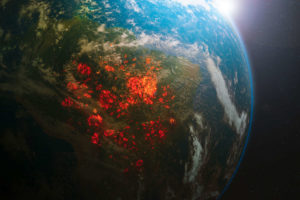Leading climate scientists say the Amazon rainforest is at an irreversible tipping point.
Jair Bolsonaro, Brazil’s far-right president could push the rainforest to the tipping point within the next 2 years. Monica de Bolle, a senior fellow at the Peterson Institute for International Economics in Washington DC., says maintaining the current rate of deforestation would bring the Amazon “dangerously close to the estimated tipping point as soon as 2021 … beyond which the rainforest can no longer generate enough rain to sustain itself.”[1]
Bolsonaro has vowed to develop the Amazon and allow mining on indigenous lands. Forest fires are up 85% from 2018 to 2019 and about 40,000 of them are burning per year in the Amazon. “With confidence, we can say that a lot of that is illegal and is happening because the government has given the nod to illegal clearing and burning across the Amazon,” said Nigel Sizer, chief program officer of Rainforest Alliance.[2]
More than a soccer field’s worth of Amazon forest is falling every minute, “Current deforestation is substantial and frightening: 17% across the entire Amazon basin and approaching 20% in the Brazilian Amazon,” leading rainforest scientists Thomas Lovejoy and Carlos Nobre wrote in Science Advances.[3] “…we conclude that with the current rate of global warming, if we exceed 20 to 25 percent deforestation, then we reach the tipping point and 50 to 60 percent of the Amazon forest would become a savanna,” say Lovejoy and Nobre.[4] “Unprecedented droughts struck the forest in 2005, 2010, 2015 and 2016, “signaling that the tipping point is at hand.””[5] “Today, we stand exactly in a moment of destiny,” Lovejoy and Nobre wrote in December 2019, “The tipping point is here, it is now.”[6]
On Oct. 23, the Guardian reported, “Lovejoy, a professor at George Mason University in Fairfax, Virginia, said that de Bolle’s projection could come true because global heating, soaring deforestation and an increase in Amazon fires have created a “negative synergy” that is accelerating its destruction – citing droughts in recent years as a warning sign.”[6a]
Climate models show “if the Amazon were completely deforested, rainfall in Texas would drop by 25%, the Sierra Nevada snowpack would get cut in half, and the coastal northwest would see a reduction in precipitation up to 20%.”[7]

Photo: Aerial view from space of 2019 wildfires. OSORIOartist/Shutterstock
“According to ESA, however, there are also a number of other pollutants that enter the air during wildfires. In 2017, scientists launched the Copernicus Sentinel-5P mission to closely monitor these types of changes in air quality.”[7a]
“For example, data from Copernicus Sentinel-5P was used to observe changes in atmospheric carbon monoxide from July to August and to examine how much formaldehyde was released from fires this year compared to 2018.”

Carbon monoxide from Amazon fires 16-31 July 2019 and 1-14 August 2019
Image Credit: ESA/Copernicus data[8]

Formaldehyde in the atmosphere August 2018 and August 2019
Image Credit: ESA/Copernicus data[9]
3 https://news.mongabay.com/2019/12/the-tipping-point-is-here-it-is-now-top-amazon-scientists-warn/
4 https://e360.yale.edu/features/will-deforestation-and-warming-push-the-amazon-to-a-tipping-point
5 https://www.businessinsider.sg/amazon-rainforest-reaching-tipping-point-deforestation-experts-warn-2019-12/
6 https://advances.sciencemag.org/content/5/12/eaba2949
6a https://www.theguardian.com/environment/2019/oct/23/amazon-rainforest-close-to-irreversible-tipping-point
7 https://www.iflscience.com/environment/the-amazon-rainforest-is-about-to-cross-an-irreversible-threshold-that-will-turn-it-into-a-savanna-top-scientists-say/
7a https://www.earth.com/news/satellites-monitor-amazon-fires/
8 https://www.earth.com/news/satellites-monitor-amazon-fires/
9 https://www.earth.com/news/satellites-monitor-amazon-fires/
